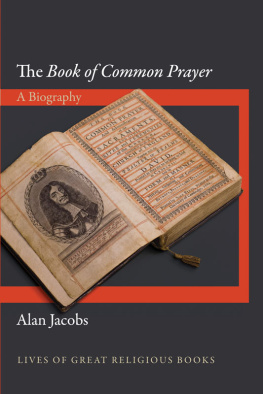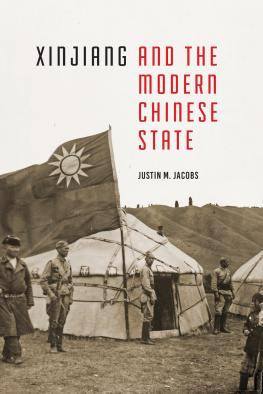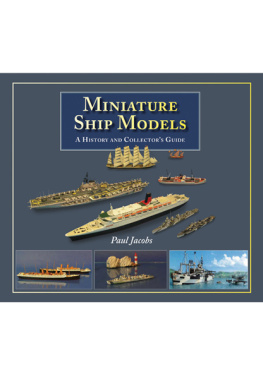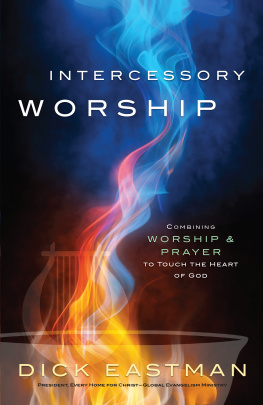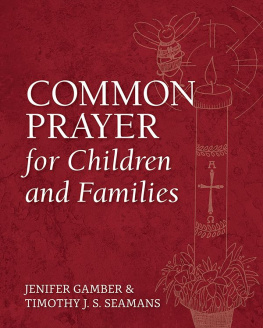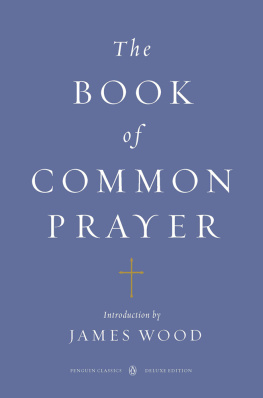
LIVES OF GREAT RELIGIOUS BOOKS
The Book of Common Prayer
LIVES OF GREAT RELIGIOUS BOOKS
The Dead Sea Scrolls, John J. Collins
The Book of Mormon, Paul C. Gutjahr
The Book of Genesis, Ronald Hendel
The Book of Common Prayer, Alan Jacobs
The Book of Job, Mark Larrimore
The Tibetan Book of the Dead, Donald S. Lopez Jr.
Dietrich Bonhoeffers Letters and Papers from Prison, Martin E. Marty
The I Ching, Richard J. Smith
Augustines Confessions, Garry Wills
FORTHCOMING:
Confuciuss Analects, Annping Chin and Jonathan D. Spence
The Bhagavad Gita, Richard H. Davis
Josephuss Jewish War, Martin Goodman
John Calvins Institutes of the Christian Religion, Bruce Gordon
The Lotus Sutra, Donald S. Lopez Jr.
C. S. Lewiss Mere Christianity, George Marsden
Thomas Aquinass Summa Theologiae, Bernard McGinn
The Greatest Translations of All Time: The Septuagint and the
Vulgate, Jack Miles
The Passover Haggadah, Vanessa Ochs
The Song of Songs, Ilana Pardes
Rumis Masnavi, Omid Safi
The Yoga Sutras of Patanjali, David Gordon White
The Book of Common Prayer
A BIOGRAPHY
Alan Jacobs
PRINCETON UNIVERSITY PRESS
Princeton and Oxford
Copyright 2013 by Princeton University Press
Published by Princeton University Press, 41 William Street,
Princeton, New Jersey 08540
In the United Kingdom: Princeton University Press,
6 Oxford Street, Woodstock, Oxfordshire OX20 1TW
press.princeton.edu
Jacket photograph: Book of Common Prayer, 1662. Courtesy of the Underwood Prayer Book Collection of the Francis Donaldson Library at Nashotah House Theological Seminary. Photography by Bliss Lemmon.
All Rights Reserved
Library of Congress Cataloging-in-Publication Data
Jacobs, Alan, 1958
The Book of Common Prayer : a biography / Alan Jacobs.
pages cm. (Lives of great religious books)
Includes index.
Summary: While many of us are familiar with such famous words as, Dearly beloved, we are gathered together here. or Ashes to ashes, dust to dust, we may not know that they originated with The Book of Common Prayer, which first appeared in 1549. Like the words of the King James Bible and Shakespeare, the language of this prayer book has saturated English culture and letters. Here Alan Jacobs tells its story. Jacobs shows how The Book of Common Prayerfrom its beginnings as a means of social and political control in the England of Henry VIII to its worldwide presence todaybecame a venerable work whose cadences express the heart of religious life for many. The books chief maker, Thomas Cranmer, Archbishop of Canterbury, created it as the authoritative manual of Christian worship throughout England. But as Jacobs recounts, the book has had a variable and dramatic career in the complicated history of English church politics, and has been the focus of celebrations, protests, and even jail terms. As time passed, new forms of the book were made to suit the many English-speaking nations: first in Scotland, then in the new United States, and eventually wherever the British Empire extended its arm. Over time, Cranmers book was adapted for different preferences and purposes. Jacobs vividly demonstrates how one book became manyand how it has shaped the devotional lives of men and women across the globeProvided by publisher.
ISBN 978-0-691-15481-7 (hardback)
1. Anglican CommunionLiturgyTextsHistory. 2. Church of England. Book of common prayerHistory. I. Title.
BX5145.J27 2013
264.03009dc23
2013019886
British Library Cataloging-in-Publication Data is available
This book has been composed in Garamond Premier Pro
Printed on acid-free paper.
Printed in the United States of America
10 9 8 7 6 5 4 3 2 1
for Wesley
CONTENTS
CHAPTER 6
CHRONOLOGY
1544 | Thomas Cranmer composes and promulgates the Great Litany |
1549 | the first Book of Common Prayer published |
1552 | second Book of Common Prayer published |
1553 | proscription of the Book of Common Prayer by Queen Mary |
1559 | the Elizabethan Book of Common Prayer published |
1604 | Hampton Court Conference convened by King James I |
1637 | a Scottish Book of Common Prayer promulgated and rescinded |
1641 | the Book of Common Prayer proscribed by Parliament |
1662 | the post-Restoration revision of the Book of Common Prayer completed and promulgated |
1789 | the first American Book of Common Prayer published |
1928 | a revised Book of Common Prayer published in America; a revised book fails to pass Parliament in Britain |
1945 | Gregory Dix publishes The Shape of the Liturgy |
1954 | first liturgies of the Church of South Indias Book of Common Worship published |
1964 | A Liturgy for Africa published |
1979 | revised American Book of Common Prayer published |
1980 | the Church of England publishes the Alternative Service Book |
2000 | the Common Worship project replaces the ASB; its work is now ongoing |
FIGURES
Figure 6
A NOTE ON TEXTS
In quoting from the early versions of the Book of Common Prayer, from 1549 to 1662, I use the superb recent edition edited by Brian Cummings, The Book of Common Prayer: The Texts of 1549, 1559, and 1662 (Oxford: Oxford University Press, 2011). In citing it I use the abbreviation BCP followed by the page number. While Cummings preserves the original spelling, I have generally modernized it slightly in the cause of readability.
Two other books have been constantly open on my desk during the writing of this book, and I have cited them frequently enough that they deserve their own abbreviations as well. One is Diarmaid MacCullochs Thomas Cranmer: A Life (New Haven, CT: Yale University Press, 1996), which shall be known here as TC. The other is The Oxford Guide to the Book of Common Prayer: A Worldwide Survey, edited by Charles Helfling and Cynthia Shattuck (New York: Oxford University Press, 2006), which I mark as OG, though adding the author and full title of each essay I quote.
LIVES OF GREAT RELIGIOUS BOOKS
The Book of Common Prayer
The Archbishop in His Library
INTRODUCTION
The archbishops palace at Croydon, south of London, sat amid low-lying woods. King Henry avoided it: of another palace belonging to the archbishop he commented, This house standeth low and is rheumatic, like unto Croydon, where I could never be without sickness.
The year was, let us say, 1543. Cranmer had made his first bold drafts of an English liturgy in 1538, but that work was not well received by the few who saw it, and he had learned to be more cautious. He sat at his desk and studied his books and thought of how he might produce a liturgy in English that would please a king whose moods and inclinations had become ever harder to predict. Henry had injured his leg at a tournament in 1536, and the wound had never healed; he had become fatter and fatter, probably gouty as well, and could scarcely move. For some years his attitudes toward reforming the church had vacillated. In the aftermath of the Act of Supremacy in 1534, which made him the head of the English Church and denied to the Church at Rome any authority in England, he showed some Reforming sympathies, but as time had gone by his love of older ways, and the old church language of Latin, had returned. After all, Christian worship in England had been conducted in Latin for a thousand years or more. Cranmer therefore understood the challenge of composing an English liturgy capable of gaining Henrys wholehearted approval.
Next page
